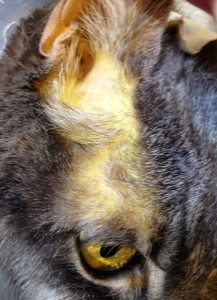Liver disease is relatively common in dogs and cats, and a lot of affected animals develop icterus or jaundice, a characteristic yellowing of the skin and sclera/the “whites” of the eyes (see pictures below).
But getting an accurate diagnosis can be challenging. Why? Diagnosis frequently requires sampling the liver. What do I mean by sampling? Sampling refers to either obtaining cells from the liver to look at under a microscopy (called aspiration with cytology) or performing a biopsy. A liver biopsy can be obtained either via a traditional abdominal surgery called a laparotomy, via laparoscopy (a minimally invasive abdominal surgery using 2 to 3 key-hole sized incisions) or with ultrasound-guidance. So let’s take a little time to discuss the ways the liver can be sampled in dogs and cats.
Liver aspiration with cytology…
Aspiration with cytology is commonly performed because it’s inexpensive and easy to perform. There is low risk to the patient, and sedation is typically not needed. We use a needle that is the size used to give a vaccination, so there is essentially no discomfort for the pet. Liver aspiration can be quite useful for patients suspected of living with certain types of cancers, including lymphoma or mast cell disease. However aspiration is not a perfect test – it not always accurate! Indeed aspirates of liver tissue are not recommended for patients suspected to be living with inflammatory disease like chronic active hepatitis in dogs and cholangiohepatitis in cats. A 2004 study published in the Journal of the American Veterinary Medical Association compared liver cytology to liver biopsies. Only 30% of dog cytology diagnoses and 51% of cat cytology diagnoses agreed with biopsy diagnoses; furthermore inflammatory disease was diagnosed correctly only 25% of the time.
Liver biopsies…
Given the limitations of aspiration with cytology, a liver biopsy is commonly required to provide the best information about disease severity and prognosis. As I mentioned above, liver biopsies can be obtained one of three ways:
- Laparotomy (traditional abdominal surgery)
- Laparoscopy
- Ultrasound-guided biopsies
An ideal liver biopsy must be of proper size and taken from the correct location in the liver. Samples should be collected for both a biopsy and measurement of specific minerals, particularly iron, copper and zinc. A sample of bile from the gall bladder should also ideally be cultured to look for a bacterial infection. Liver biopsies obtained via laparotomy are the gold standard sample. Of course this surgery is invasive, and thus we always want to consider less invasive techniques like laparoscopy and ultrasound-guided biopsies. But we have to ask ourselves if these minimally invasive techniques have comparable accuracy!
Ultrasound-guided biopsies: Given very small size of ultrasound-guided liver biopsies, there’s a much greater potential for the sample to not represent the underlying disease process. One good ultrasound-guided biopsy reportedly represents only a 50,000th of the entire liver. A 2002 study published in the Journal of the American Veterinary Medical Association compared ultrasound-guided biopsies to laparotomy biopsies (the gold standard) in both dogs and cats. The results of this study showed ultrasound-guided biopsies agreed with laparotomy biopsies only 44-65% of the time. Ultrasound-guided biopsies can be challenging to perform accurately and safely, and thus the training and clinical experience of a board-certified radiologist or internal medicine specialist is invaluable.
Laparoscopy: This modality is a step between an ultrasound-guided biopsy and laparotomy to obtain liver tissue. Benefits of laparoscopy include improved patient recovery, lower post-operative morbidity, decreased infection rate and post-operative discomfort and shorter length of hospital stay. Diagnostic accuracy of laparoscopic liver biopsies is quite comparable to laparotomy biopsy samples. Performing laparoscopy requires very specialized equipment and extensive training, and accordingly is most commonly performed by board-certified surgeons and internal medicine specialists.
The take-away message about liver sampling…
If your pet is suspected to be living with a cancer like lymphoma or mast cell disease in the liver, an internal medicine specialist will likely recommend initially performing aspiration with cytology. But for patients suspected of living with inflammatory liver disease (i.e. chronic hepatitis, cholangiohepatitis), portosystemic vascular anomalies (aka: shunting disorders), and fibrosis (liver scarring), a laparotomy or laparoscopic biopsies is/are recommended. Many board-certified internal medicine specialists are moving away from the ultrasound-guided biopsy technique, as the quality of the samples is such that many times the biopsy results are often vague and relatively useless.
Wishing you wet nosed kisses,
cgb



dUe date calculator
do you have a twitter that i can follow
criticalcaredvm
Yes! I’d love for you to follow me on Twitter. There is a link at the top righthand area of the blog or you can find me at @CritcalCareDVM. Thanks for the support!
zbawienie
I have been surfing online more than 3 hours today, yet I never found any interesting article like yours. It is pretty worth enough for me. In my view, if all website owners and bloggers made good content as you did, the net will be a lot more useful than ever before.
criticalcaredvm
Wow! Thank you for the truly kind words – I appreciate them very much! I’m so pleased you are enjoying my posts. I would be most appreciative of you sharing my site info with other pet parents so they, too, can know that pets can have specialists too.